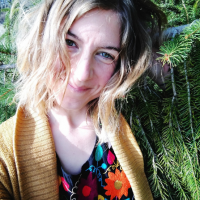View this post on Instagram
I’m grieving the end of my marriage, eight years of trauma, and my old life, but I can’t stop thinking about my Dad.
I lost him almost twelve years ago. The grief lives on, as grief is known to do. I will never cease to miss him.
Grief is like this.
We might begin grieving one thing—a lost relationship, lost job, lost dream, or a lost sense of normality in the world—and then end up grieving another thing entirely.
This something could be systemic racism, climate destruction, our dog who died three years ago, an old friendship, or the person we used to be. Soon, we may find ourselves grieving the whole world.
Grief is dynamic, fluid, colorful, and messy.
It is not an inked drawing with clearly delineated lines. Grief is a watercolor painting with sweeping strokes that blend into others. There are autonomous shapes, held in outline, and there are places where borders softly fade into a blur.
Grief has a flair for abstraction. It is more Picasso than Rembrandt, noses placed on foreheads and ears for mouths, causing one to squint and wonder if they are, in fact, sane.
In truth, I would often prefer my grief to be distinct, separate, and easily contained. I want to look at it and perceive it in its most explicit form. I would like to see stark lines holding colors and shapes in their proper places. There is less for the imagination here, but this can comfort the brain’s exhausting search for organization.
Instead, whenever I’m grieving something deeply, my Dad’s absence bubbles to the surface and spills across the page in watery strokes.
I’ve been biking the country roads around my new home of Upstate New York, admiring the sites—the tall grass fields, the ponds tucked alongside these fields, the woods with filtered light and trees wrapped in vines, the groundhogs bobbing in yards as they feast, the unidentified birds singing from telephone wires, the rows of apple trees in orchards, the old farmhouses with shuttered windows and spacious porches.
Everywhere I go around here, memories of my Dad trail behind me.
I passed a quaint cottage with a low stone wall and, unbidden, the tears began streaming down my face as I rode. Further down, a white farmhouse with a wrap-around porch and rocking chairs draped in blankets pierced me with longing. He loved old houses and fixer-uppers—the more “character,” the better. I inherited this from him.
There is not much I wouldn’t give for one more afternoon with him, in a place like this, rocking on that porch in a balmy summer breeze, sipping iced teas, and saying very little. We were similar in this way, comfortable in silence. Not because we had nothing to say, but because we lived richly within our internal worlds, soaking everything in like a sponge before releasing it into words.
He was a kindred spirit, and I lost him. He can never be replaced.
I kept peddling, the vision of my Dad and me on the porch slowly fading. Of course, I can never have another afternoon with him like this, no matter how I might long for it.
Until it occurred to me that this is only partially true: I can access him like this whenever I open myself to the moment. He is always available to me in this way.
One of the few belongings of my Dad’s that I kept after he died were his binoculars. They are a tangible reminder that I can always see the world through his eyes. He is in my eyes. Wherever he now exists in space and time, I feel him peering out in curious delight and observation of the world—through me, beside me, all around me.
He still is. His form has simply changed.
When my breath catches in my throat at the sight of a crumbling stone house with eyelet curtains in the windows—a white picket fence, birdhouses hanging from trees, a pair of rocking chairs—we might as well be sitting there, together, in companionable silence.
When I gasp like a child following the flight of a cardinal before she disappears in the forest—or crane my neck to look up at a hawk floating overhead and laugh in wondrous awe—he might as well be beside me, binoculars in hand, savoring the world.
Any moment (of any day) that I am mindful of him is a “rocking-chair-on-the-front-porch, sipping-iced-tea” sort of moment I still get to share with my Dad.
This is the lesser-known gift of grief. We can continue to cultivate relationships with the ones we love, even after losing their physical presence. We can still have conversations with them—if we choose to. We can learn to listen for the voices that no longer speak audibly, but instead through birds and trees and houses, children and books and binoculars, and even grief itself.
Rather than being an additional source of pain, perhaps the way these relationships continue to spill soft colors across our canvases is meant to guide us as we navigate the world of watercolor grief.
Everything flows into everything else. With gentle repetition, I’m beginning to relax into the comfort of this truth.










Read 23 comments and reply